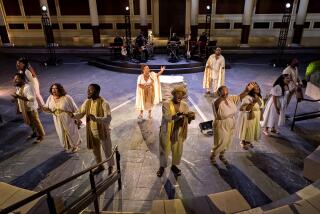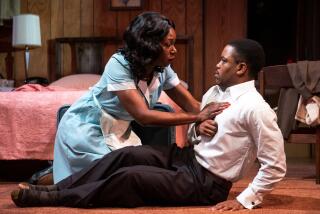TV REVIEWS : Heston Serves a Lively Version of the Bible
- Share via
There are plenty of old jokes still floating around about how Chuck Heston didn’t really want to play Moses in “The Ten Commandments” or John the Baptist in “The Greatest Story Ever Told”; he wanted Top Billing, as the gags would have it. All these decades later, the actor finally does get to play God--along with Moses, the Baptist, Satan, Christ and all the other key parts--in “Charlton Heston Presents the Bible,” a four-hour “performance-documentary” for TV and home video.
(The four individual hours--which cover Genesis, Exodus and the New Testament gospels--premiere separately on consecutive nights Sunday through Wednesday at 5 and 9 p.m. on the Arts & Entertainment Network. For those so inclined to make it a marathon, all four hours air together Friday, Christmas Day, from 1 to 5 p.m.)
The credits bill this as “redactions” of the King James--along with interstitial commentaries--by Heston, who orates from key spots in Israel. The emphasis isn’t so much on faith as on the Bible as literature and history, with Heston emphasizing the narratives’ origins as oral texts, strolling alone through a torchlit ancient amphitheater as the campfire storyteller.
If you’re fairly certain ahead of time you won’t be able to stand Heston dramatizing the biblical texts in the style of Shakespearean soliloquies, you probably won’t. His Master Thespian style (reading Cain as scared and rabbity, the serpent as sly and sneaky, and so on) definitely isn’t for all tastes. But if you’re ready for something more dramaturgical after years of monotonal readings in mainline churches, Heston’s hammy but lively version has its value. It’ll certainly have a long life on video as the VHS equivalent to the Scourby audiotapes.
The visuals that director Tony Westman has come up with for the piece are inevitable but sometimes at odds with each other. Heston’s homespun visits to the Via Dolorosa and other locations are meant to reinforce the historicity of the texts; his readings, though, are largely accompanied by Renaissance-era paintings offering the most idealistic and unbelievable imaginings of biblical events. It’s a nice way to catch up on Bethlehem and Botticelli, but the two together don’t quite present a unified vision of the ancient world.
More to Read
The complete guide to home viewing
Get Screen Gab for everything about the TV shows and streaming movies everyone’s talking about.
You may occasionally receive promotional content from the Los Angeles Times.






